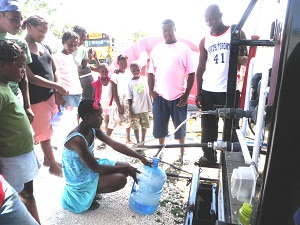Solar lights the way for a new Haiti, part 4
 Using solar to light the way for a new Haiti
Using solar to light the way for a new Haiti
While solar helped Haiti through the darkest hours after the quake, several organizations are still working in Haiti to expand the scope of solar power there and integrate it into the country’s slowly developing infrastructure.
The Solar Electric Light Fund, a nonprofit dedicated to bringing clean energy solutions to developing nations, is working with nonprofit Partners In Health to install ten 10- to 35-kilowatt solar systems in clinics across the central plateau of Haiti.
The organization successfully installed a system at the clinic in Boucan Carre, Haiti last summer, allowing the clinic to operate uninterrupted during the disaster in January, said SELF executive director Bob Freling.
His organization also received a $1 million funding pledge from NRG Energy through the Clinton Global Initiative in September to expand the use of solar power in Boucan Carre. SELF will work to install solar photovoltaic systems there that will power fish farms, drinking water, irrigation, streetlights, schools, clinics and other enterprises, Freling said.
“The idea is to turn Boucan Carre into a model community that can light the way for the rest of Haiti,” Freling said.
He said his organization has hired a full-time project manager in Haiti and expects to hire more staff there for all of its major upcoming projects.
Water purification has proven to be one of the most important applications for solar technology since Haiti was hard-hit with Cholera outbreaks this fall.
World Water & Solar Technologies is operating five solar water purifiers in Haiti now, said marketing director Melissa Burns.
The company had sent one of its systems to Haiti before the earthquake as a preparatory measure for hurricanes there.
The system is equipped with a 3.3-kilowatt solar photovoltaic system and battery backup. It can purify 30,000 gallons of water a day using just half of the system’s solar generated power, Burns said.
That’s as much water as a 747 jet could carry if fully packed with plastic water bottles, she said.
The other half of the power can be used to charge cell phones and computers and run lights.
“The pay-back on our system, if you compare it to bottled water, is three days” Burns said.
World Water & Solar Technologies is now looking for sponsors so it can expand its presence in Haiti.
“With the Cholera outbreaks, water purification is even more relevant than before,” Burns said.
The systems, while especially helpful in disaster situations and in the after-math of disasters, can become part of Haiti’s continuing infrastructure, Burns said. The company is trying to establish water purifiers in communities across the country.
Story continues here.
Pictured: Bon Repos clean water, courtesy of World Water & Solar Technologies.



